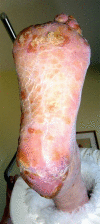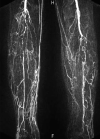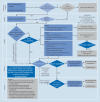[Diabetic foot syndrome-Part 1 : Definition, pathophysiology, diagnostics and classification]
- PMID: 33170315
- PMCID: PMC7819949
- DOI: 10.1007/s00104-020-01301-9
[Diabetic foot syndrome-Part 1 : Definition, pathophysiology, diagnostics and classification]
Abstract
There are ca. 8 million persons with diabetes mellitus living in Germany. A late sequelae of diabetes is the diabetic foot syndrome (DFS), the prevalence of which is greatly increasing. It comprises all alterations of the foot as a result of diabetic polyneuropathy as well as microvascular and macrovascular (peripheral arterial occlusive disease, PAOD) alterations. Many of the ca. 250,000 newly diagnosed diabetic foot ulcers per year become chronic wounds. Despite intensive efforts for prevention, early diagnosis and adequate wound care, ca. 13,000 persons with diabetes undergo major limb amputation in Germany every year. With consistent treatment in interdisciplinary centers and by exhausting all possible methods of wound treatment, pressure relief as well as arterial revascularization, the major amputation rate in patients with diabetic foot problems can be reduced by 80%. With a suitable strategy of prevention, the recurrence rate of foot ulcers would be reduced.
In Deutschland leben ca. 8 Mio. Menschen mit Diabetes mellitus. Eine Spätfolge dieser Erkrankung ist das diabetische Fußsyndrom (DFS), dessen Prävalenz stark ansteigt. Es umfasst alle Veränderungen am Fuß als Folge der diabetischen Polyneuropathie sowie mikro- und makroangiopathischer (periphere arterielle Verschlusskrankheit, PAVK) Veränderungen. Jährlich entstehen ca. 250.000 neue diabetische Fußulzera. Diese werden oft zu chronischen Wunden. Trotz intensiver Bemühungen um Prävention, frühzeitige Diagnostik und stadiengerechte Wundbehandlung werden in Deutschland jährlich ca. 13.000 Majoramputationen bei Diabetikern durchgeführt. Bei konsequenter Therapie des DFS in interdisziplinären Zentren mit Ausschöpfung aller Möglichkeiten der Wundbehandlung, der Druckentlastung sowie einer arteriellen Revaskularisation kann die Majoramputationsrate um bis zu 80 % gesenkt werden. Durch eine geeignete Präventionsstrategie wäre die große Gefahr der Rezidivulzera geringer.
Keywords: Amputation; Diabetes mellitus; Diabetic foot syndrome; Diabetic polyneuropathy; Peripheral arterial occlusive disease.
References
-
- Prompers L, Schaper N, Apelqvist J, et al. Prediction of outcome in individuals with diabetic foot ulcers: focus on the differences between individuals with and without peripheral arterial disease. The EURODIALE study. Diabetologia. 2008;51:747–775. doi: 10.1007/s00125-008-0940-0. - DOI - PMC - PubMed
MeSH terms
LinkOut - more resources
Full Text Sources
Medical














